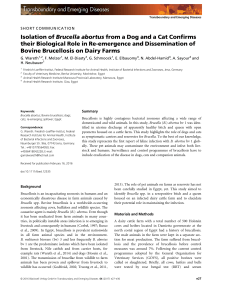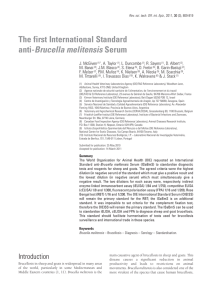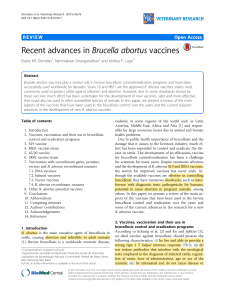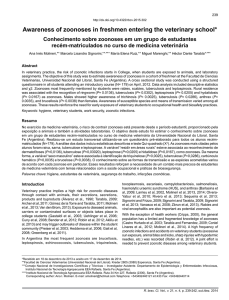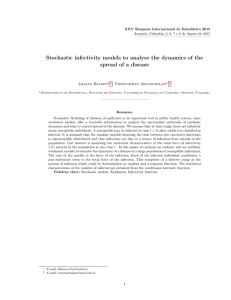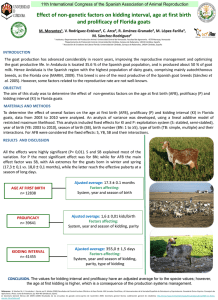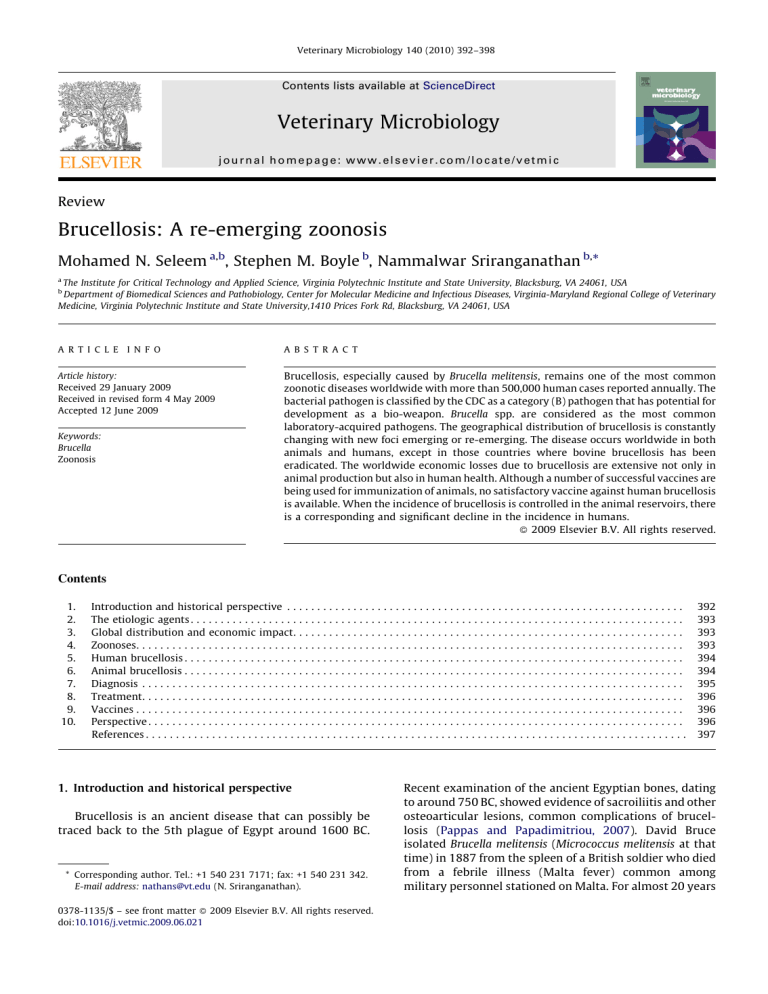
Veterinary Microbiology 140 (2010) 392–398 Contents lists available at ScienceDirect Veterinary Microbiology journal homepage: www.elsevier.com/locate/vetmic Review Brucellosis: A re-emerging zoonosis Mohamed N. Seleem a,b, Stephen M. Boyle b, Nammalwar Sriranganathan b,* a The Institute for Critical Technology and Applied Science, Virginia Polytechnic Institute and State University, Blacksburg, VA 24061, USA Department of Biomedical Sciences and Pathobiology, Center for Molecular Medicine and Infectious Diseases, Virginia-Maryland Regional College of Veterinary Medicine, Virginia Polytechnic Institute and State University,1410 Prices Fork Rd, Blacksburg, VA 24061, USA b A R T I C L E I N F O A B S T R A C T Article history: Received 29 January 2009 Received in revised form 4 May 2009 Accepted 12 June 2009 Brucellosis, especially caused by Brucella melitensis, remains one of the most common zoonotic diseases worldwide with more than 500,000 human cases reported annually. The bacterial pathogen is classified by the CDC as a category (B) pathogen that has potential for development as a bio-weapon. Brucella spp. are considered as the most common laboratory-acquired pathogens. The geographical distribution of brucellosis is constantly changing with new foci emerging or re-emerging. The disease occurs worldwide in both animals and humans, except in those countries where bovine brucellosis has been eradicated. The worldwide economic losses due to brucellosis are extensive not only in animal production but also in human health. Although a number of successful vaccines are being used for immunization of animals, no satisfactory vaccine against human brucellosis is available. When the incidence of brucellosis is controlled in the animal reservoirs, there is a corresponding and significant decline in the incidence in humans. ß 2009 Elsevier B.V. All rights reserved. Keywords: Brucella Zoonosis Contents 1. 2. 3. 4. 5. 6. 7. 8. 9. 10. Introduction and historical perspective . . . . . . . . . . . . . . . . . . . . . . . . . . . . . . . . . . . . . . . . . . . . . . . . . . . . . . . . . . . . . . . . . . The etiologic agents . . . . . . . . . . . . . . . . . . . . . . . . . . . . . . . . . . . . . . . . . . . . . . . . . . . . . . . . . . . . . . . . . . . . . . . . . . . . . . . . . . Global distribution and economic impact. . . . . . . . . . . . . . . . . . . . . . . . . . . . . . . . . . . . . . . . . . . . . . . . . . . . . . . . . . . . . . . . . Zoonoses. . . . . . . . . . . . . . . . . . . . . . . . . . . . . . . . . . . . . . . . . . . . . . . . . . . . . . . . . . . . . . . . . . . . . . . . . . . . . . . . . . . . . . . . . . . Human brucellosis . . . . . . . . . . . . . . . . . . . . . . . . . . . . . . . . . . . . . . . . . . . . . . . . . . . . . . . . . . . . . . . . . . . . . . . . . . . . . . . . . . . Animal brucellosis . . . . . . . . . . . . . . . . . . . . . . . . . . . . . . . . . . . . . . . . . . . . . . . . . . . . . . . . . . . . . . . . . . . . . . . . . . . . . . . . . . . Diagnosis . . . . . . . . . . . . . . . . . . . . . . . . . . . . . . . . . . . . . . . . . . . . . . . . . . . . . . . . . . . . . . . . . . . . . . . . . . . . . . . . . . . . . . . . . . Treatment. . . . . . . . . . . . . . . . . . . . . . . . . . . . . . . . . . . . . . . . . . . . . . . . . . . . . . . . . . . . . . . . . . . . . . . . . . . . . . . . . . . . . . . . . . Vaccines . . . . . . . . . . . . . . . . . . . . . . . . . . . . . . . . . . . . . . . . . . . . . . . . . . . . . . . . . . . . . . . . . . . . . . . . . . . . . . . . . . . . . . . . . . . Perspective . . . . . . . . . . . . . . . . . . . . . . . . . . . . . . . . . . . . . . . . . . . . . . . . . . . . . . . . . . . . . . . . . . . . . . . . . . . . . . . . . . . . . . . . . References . . . . . . . . . . . . . . . . . . . . . . . . . . . . . . . . . . . . . . . . . . . . . . . . . . . . . . . . . . . . . . . . . . . . . . . . . . . . . . . . . . . . . . . . . . 1. Introduction and historical perspective Brucellosis is an ancient disease that can possibly be traced back to the 5th plague of Egypt around 1600 BC. * Corresponding author. Tel.: +1 540 231 7171; fax: +1 540 231 342. E-mail address: [email protected] (N. Sriranganathan). 0378-1135/$ – see front matter ß 2009 Elsevier B.V. All rights reserved. doi:10.1016/j.vetmic.2009.06.021 392 393 393 393 394 394 395 396 396 396 397 Recent examination of the ancient Egyptian bones, dating to around 750 BC, showed evidence of sacroiliitis and other osteoarticular lesions, common complications of brucellosis (Pappas and Papadimitriou, 2007). David Bruce isolated Brucella melitensis (Micrococcus melitensis at that time) in 1887 from the spleen of a British soldier who died from a febrile illness (Malta fever) common among military personnel stationed on Malta. For almost 20 years M.N. Seleem et al. / Veterinary Microbiology 140 (2010) 392–398 after isolation of M. melitensis, Malta fever remained a mystery and was thought to be a vector-borne disease until Themistocles Zammit accidentally demonstrated the zoonotic nature of the disease in 1905 by isolating B. melitensis from goat’s milk. It was believed that goats were not the source of infection since they did not become ill when inoculated with Brucella cultures. The discovery that healthy goats could be carriers of the disease has been termed one of the greatest advances ever made in the study of epidemiology (Sriranganathan et al., 2009; Wyatt, 2005). In 1897, a Danish veterinarian, L.F. Benhard Bang, discovered Bang’s bacillus or bacillus of cattle abortion (B. abortus) to be the causative agent of Bang’s disease. Alice Evans, an American scientist who did landmark work on pathogenic bacteria in dairy products, confirmed the relationship between Bang’s disease and Malta fever and renamed the genus Brucella to honor David Bruce. Her work on Brucella was central in gaining acceptance of the pasteurization process to prevent human brucellosis in USA. The discovery of the Brucella in marine mammals in early 1990 has changed the concept of a land-based distribution of brucellosis and associated control measures (Sriranganathan et al., 2009). 2. The etiologic agents Brucella spp. are facultative intracellular gram-negative cocco-bacilli, non-spore-forming and non-capsulated. Although Brucella spp. are described as non-motile, they carry all the genes except the chemotactic system, necessary to assemble a functional flagellum (Fretin et al., 2005). They belong to the alpha-2 subdivision of the Proteobacteria, along with Ochrobactrum, Rhizobium, Rhodobacter, Agrobacterium, Bartonella, and Rickettsia (Yanagi and Yamasato, 1993). Nine Brucella species are currently recognized, seven of them that affect terrestrial animals are: B. abortus, B. melitensis, B. suis, B. ovis, B. canis, B. neotomae, and B. microti (Scholz et al., 2008; Verger et al., 1987) and two that affect marine mammals are: B. ceti and B. pinnipedialis (Foster et al., 2007). The first three species are called classical Brucella and within these species, seven biovars are recognized for B. abortus, three for B. melitensis and five for B. suis. The remaining species have not been differentiated into biovars. The strains of brucellae were named based on the host animal preferentially infected (Verger et al., 1987). Ten genome sequences representing five species of Brucella (B. melitensis, B. suis, B. abortus, B. ovis, and B. canis) are available and about 25 additional Brucella strains/ species are being sequenced (D. O’Callaghan, personal communication). The genomes of the members of Brucella are very similar in size and gene makeup (Sriranganathan et al., 2009). Each species within the genus has an average genome size of approximately 3.29 Mb and consists of two circular chromosomes, Chromosome I, is approximately on average 2.11 Mb and Chromosome II is approximately 1.18 Mb. The G + C content of all Brucella genomes is 57.2% for Chromosome I and 57.3% for Chromosome II (DelVecchio et al., 2002; Halling et al., 2005; Paulsen et al., 2002). Based on a comparison of 10 published Brucella genomes, what is striking are the shared anomalous regions found in 393 both chromosomes consistent with horizontal gene transfer in spite of a predominantly intracellular life style (Wattam et al., 2009). The brucellae have no classic virulence genes encoding capsules, plasmids, pili or exotoxins and compared to other bacterial pathogen relatively little is known about the factors contributing to the persistence in the host and multiplication within phagocytic cells. Also, many aspects of interaction between Brucella and its host remain unclear (Seleem et al., 2008). 3. Global distribution and economic impact The geographical distribution of brucellosis is constantly changing, with new foci emerging or re-emerging. The epidemiology of human brucellosis has drastically changed over the past few years because of various sanitary, socioeconomic, and political reasons, together with increased international travel. New foci of human brucellosis have emerged, particularly in central Asia, while the situation in certain countries of the Middle East is rapidly worsening (Pappas et al., 2006b). The disease occurs world wide, except in those countries where bovine brucellosis (B. abortus) has been eradicated. This is defined as the absence of any reported cases for at least five years. These countries include Australia, Canada, Cyprus, Denmark, Finland, The Netherlands, New Zealand, Norway, Sweden and the United Kingdom. The Mediterranean Countries of Europe, northern and eastern Africa, Near East countries, India, Central Asia, Mexico and Central and South America are still not brucellosis free. While B. melitensis has never been detected in some countries, there are no reliable reports that it has ever been eradicated from small ruminants in any country (Robinson, 2003). Although in most countries brucellosis is a nationally notifiable disease and reportable to the local health authority, it is under reported and official numbers constitute only a fraction of true incidence of the disease. Thus the true incidence of human brucellosis is unknown and the estimated burden of the disease varies widely, from <0.03 to >160 per 100,000 population (Pappas et al., 2006b; Taleski et al., 2002). Although estimates of the costs associated with brucellosis infections remain limited to specific countries, all data suggest that worldwide economic losses due to brucellosis are extensive not only in animal production (reduced milk, abortion and delayed conception), but also in public health (cost of treatment and productivity loss). For example, official estimates put annual losses due to bovine brucellosis in Latin America at approximately $600 million. Although brucellosis eradication programs can be very expensive, they are estimated to save $7 for each $1 spent on eradication. The USA national brucellosis eradication program, while costing $3.5 billion between 1934 and 1997, the cost of reduced milk production and abortion in 1952 alone was $400 million (Acha et al., 2003; Sriranganathan et al., 2009). 4. Zoonoses Five out of the nine known Brucella species can infect humans and the most pathogenic and invasive species for human is B. melitensis, followed in descending order by B. 394 M.N. Seleem et al. / Veterinary Microbiology 140 (2010) 392–398 suis, B. abortus and B. canis (Acha et al., 2003). The zoonotic nature of the marine brucellae (B. ceti) has been documented (Brew et al., 1999; McDonald et al., 2006; Sohn et al., 2003). B. melitensis, B. suis and B. abortus are listed as potential bio-weapons by the Centers for Disease Control and Prevention in the USA. This is due to the highly infectious nature of all three species, as they can be readily aerosolized. Moreover, an outbreak of brucellosis would be difficult to detect because the initial symptoms are easily confused with those of influenza (Chain et al., 2005). In places where brucellosis is endemic, humans can get infected via contact with infected animals or consumption of their products, mostly milk and milk products especially cheese made from unpasteurized milk of sheep and goats and rennet from infected lambs and kids. Some specific occupational groups including farm workers, veterinarians, ranchers, and meat-packing employees are considered at higher risk (Tabak et al., 2008). B. abortus and B. suis infections usually affect occupational groups, while B. melitensis infections occur more frequently than the other Brucella species in the general population (Acha et al., 2003; De Massis et al., 2005). Consumption of sheep or goat milk containing B. melitensis is an important source of human brucellosis worldwide and has caused several outbreaks. For example; in some countries including Italy, 99% of human brucellosis is caused by B. melitensis (De Massis et al., 2005; Wallach et al., 1997). The prevalence of human brucellosis acquired from dairy products in some countries is seasonal, reaching a peak usually after kidding and lambing (Dahouk et al., 2007). Because person-to-person transmission rarely occurs, infected persons do not pose a threat to their surroundings; consequently, eradication of the disease from the natural animal reservoirs leads to a dramatic decrease in the incidence of human infection. For example, in the United States the national bovine brucellosis eradication program has resulted in the number of reported human cases dropping from 6321 in 1947 to about 100 per year by 1998; most of the cases were acquired overseas or due to consumption of infected milk products from Mexico (Cook et al., 2002). In Denmark, where some 500 cases per year reported between 1931 and 1939, human brucellosis had disappeared by 1962 as a result of eradication of brucellosis in cattle (Acha et al., 2003). In France with the introduction of brucellosis eradication program more than 800 cases of human brucellosis were reported in 1976, declining to 405 cases in 1983, 125 cases in 1990, and 44 cases in 2000 (Pappas et al., 2006b). In countries where milk and dairy products are always pasteurized before consumption, brucellosis principally affect persons who are in close contact with animals and animal products. Although Brucella is considered highly infectious when encountered via the respiratory route (e.g. 10 bacteria required for infection in mice), inhalation of Brucella is not a common route of infection, but it can be a significant hazard for people in certain occupations, such as those people working in laboratories or abattoirs. In fact, Brucella spp. are considered as the most common laboratoryacquired pathogens, and they are estimated to account for up to 2% of all laboratory-associated infections (Mense et al., 2001; Olle-Goig and Canela-Soler, 1987; Robichaud et al., 2004). A Spanish survey conducted in 1999 showed that 11.9% of the 628 surveyed clinical microbiology laboratory workers had suffered from laboratory-acquired brucellosis (Bouza et al., 2005). 5. Human brucellosis One of the best descriptions of human brucellosis before discovery of antibiotics was ‘‘the disease rarely kills anybody, but it often makes a patient wish he were dead’’ (TIME magazine 1943). The incubation period of brucellosis normally is 1–3 weeks, but it can be several months before showing signs of infection. B. melitensis is associated with acute infection whereas the infections with other species are usually subacute and prolonged (Mantur et al., 2007). Most common symptoms of brucellosis include undulant fever in which the temperature can vary from 37 8C in the morning to 40 8C in the afternoon; night sweats with peculiar odor, chills and weakness. Common symptoms also include malaise, insomnia, anorexia, headache, arthralgia, constipation, sexual impotence, nervousness and depression (Acha et al., 2003). Human brucellosis is also known for complications and involvement of internal organs and its symptoms can be very diverse depending on the site of infection and include encephalitis, meningitis, spondylitis, arthritis, endocarditis, orchitis, and prostatitis (Acha et al., 2003). Spontaneous abortions, mostly in the first and second trimesters of pregnancy, are seen in pregnant women infected with Brucella (Khan et al., 2001). Although rare complication, Brucella endocarditis (<2% of cases) is most commonly associated with B. melitensis infection and is the most severe complication. It accounts for at least 80% of deaths due to brucellosis (Peery and Belter, 1960; Reguera et al., 2003). Lack of appropriate therapy during the acute phase may result in localization of brucellae in various tissues and organs and lead to subacute or chronic disease that is very hard to treat (Young, 1995). Symptoms and signs of brucellosis usually referred as fever of unknown origin can be confused with other diseases including enteric fever, malaria, rheumatic fever, tuberculosis, cholecystitis, thrombophlebitis, fungal infection, autoimmune disease and tumors (Mantur et al., 2007). Live animal vaccines B. melitensis Rev. 1 and B. abortus strain 19 are known to cause disease in humans. The course of the disease with vaccine strains is usually shorter and more benign (Acha et al., 2003). Direct person-to-person spread of brucellosis is extremely rare. Mothers who are breast-feeding may transmit the infection to their infants and sexual transmission has also been reported (Arroyo Carrera et al., 2006; Kato et al., 2007). 6. Animal brucellosis In livestock species (cattle, sheep, goats, swine, and camel), the most frequent clinical sign following infection with Brucella is abortion (Acha et al., 2003). The principal strain that infects cattle is B. abortus, cattle can also become transiently infected by B. suis and more commonly by B. melitensis when they share pasture or facilities with infected pigs, goats and sheep. B. melitensis and B. suis can be M.N. Seleem et al. / Veterinary Microbiology 140 (2010) 392–398 transmitted by cow’s milk and cause a serious public health threat (Acha et al., 2003; Ewalt et al., 1997; Kahler, 2000). The main symptoms in pregnant females is abortion (premature or full term birth of dead or weak calves) usually in the second half of gestation with retention of placenta and metritis (Acha et al., 2003). There is an estimated 25% reduction in milk production in infected cows (Acha et al., 2003). The brucellae localize in the supra-mammary lymph nodes and mammary glands of 80% of the infected animals and thus continue to secrete the pathogen in milk throughout their lives (Hamdy and Amin, 2002). Most infected cows abort only once although the placenta will be heavily infected at subsequent apparently normal calvings (Morgan, 1969). The main etiologic agent of brucellosis in goats is B. melitensis. In certain countries like Brazil where there is no B. melitensis, goats can get infected with B. abortus (Lilenbaum et al., 2007). As in cattle, brucellosis in goats is characterized by late abortion, stillbirths, decreased fertility and low milk production (Lilenbaum et al., 2007). Sheep brucellosis can be divided into classical brucellosis and ram epididymitis. Ram epididymitis is caused by non-zoonotic agent B. ovis, while classical brucellosis is caused by B. melitensis and constitutes a major public health threat equal to goat brucellosis (Acha et al., 2003). Besides the abortion, swine may also develop orchitis, lameness, hind limb paralysis, or spondylitis; occasionally, metritis or abscesses (Glynn and Lynn, 2008). Camels can be infected by B. abortus and B. melitensis when they are pastured together with infected sheep, goats and cattle. Milk from infected camels represent a major source of infection that is underestimated in the Middle East (Musa et al., 2008). The main etiologic agent for dog brucellosis is B. canis, but sporadic cases of brucellosis in dogs caused by B. abortus, B. suis and B. melitensis have been reported (Acha et al., 2003). Dogs infected with B. canis may have reproductive related conditions (abortions during the last third of a pregnancy, stillbirths, or conception failures) and/or nonreproductive tract related conditions (including ocular, musculoskeletal, or dermatologic lesions) (Acha et al., 2003; Wanke, 2004). Humans are susceptible to B. canis, although less than classic brucellae, several cases have reported in the US, Mexico, Brazil, and Argentina (Acha et al., 2003). 7. Diagnosis Human brucellosis presents a great variety of clinical manifestations making it difficult to diagnose clinically. In some endemic areas every case of human fever of unknown origin is assumed to be due to brucellosis. Therefore, the diagnosis must be confirmed by laboratory tests. Accurate and fast diagnosis of human brucellosis is very important as delay or misdiagnosis usually results in treatment failures, relapses, chronic courses, focal complications, and a high case-fatality rate (Dahouk et al., 2007). A detailed case history is very important for diagnosis especially in non-endemic areas to rule out travel- 395 associated brucellosis or consumption of contaminated milk products imported from endemic areas. Isolation of Brucella from blood, bone marrow, lymph nodes or cerebrospinal fluids remains the gold-standard for diagnosis of brucellosis in humans, yet culture cannot practically be used as a screening test. Despite its high specificity, Brucella culture has several drawbacks such as slow growth and poor sensitivity. The low sensitivity for isolation is dependent on many factors including; the individual laboratory practices, quantity of pathogen in clinical samples, stage of infection, use of antibiotics before diagnoses, the methods used for culturing and the cultured strain (B. melitensis is more readily cultured from clinical sample than B. abortus). The sensitivity of detection varies from 15% to 70% of acutely infected patients and is even lower in chronically infected patients. Recently, higher rates of positive blood cultures (91% in acute brucellosis and 74% in chronic brucellosis) have been reported by lysis centrifugation technique (Acha et al., 2003; Glynn and Lynn, 2008; Mantur and Mangalgi, 2004). Serological tests for antibody detection that measure the ability of serum to agglutinate a standardized amount of killed B. abortus reflect the presence of antibody against O-side chain (derived from lipopolysaccharide). Brucella specific IgM appearing at the end of the first week of the disease followed by IgG are still the most common and useful measures for the laboratory diagnosis of brucellosis, also they are faster and reduce risk of laboratory-acquired infections due to handling Brucella culture (Mantur et al., 2007). These agglutinations tests, however, are not useful for diagnosis of infection caused by B. canis (a naturally Oside chain deficient strain). Serum agglutination test referred as the standard tube Brucella agglutination test (STT) is commonly used for diagnoses of acute brucellosis. However 2-mercaptoethanol (2ME) and complement fixation tests (CFTs) are used for chronic brucellosis, where active infection continues even though agglutination titers return to low levels (Acha et al., 2003). The 2ME test is performed identically to the STT test except for the addition of 2ME that disrupts disulfide bonds, making immunoglobulin M antibodies inactive and permitting only Brucella agglutination by immunoglobulin G resistant to 2ME disruption. This inactivation characteristic of the 2ME is very useful in predicting the recovery from brucellosis and determining adequacy of the antibiotic therapy (Buchanan and Faber, 1980). Other useful tests for diagnosis of human brucellosis are the Rose Bengal test (RBT), counterimmunoelectrophoresis (CIEP), Coombs test, immunocapture agglutination test (Brucellacapt), latex agglutination, the indirect enzyme-linked immunosorbent assay (ELISA) (Acha et al., 2003; Orduna et al., 2000). Molecular diagnosis of human brucellosis using polymerase chain reaction (PCR) based assays has been proposed as a useful and more sensitive tool but has not been validated for standard laboratory use (Kattar et al., 2007). Immunological testing for brucellosis among livestock is usually conducted as a component of the disease eradication and surveillance program rather than as diagnostic support and each country has a different policy for testing livestock. In USA the two primary methods of testing of brucellosis in cattle are: the Brucella ring test (detect 396 M.N. Seleem et al. / Veterinary Microbiology 140 (2010) 392–398 antibody in pooled milk samples from dairy herds) and the market cattle identification blood test (to test serum antibodies in blood samples) (Glynn and Lynn, 2008). No serological test has been shown to be reliable in routine diagnosis of swine brucellosis. For the identification of infected herds, the buffered Brucella antigen tests (BBAT), i.e. the buffered plate agglutination test and Rose Bengal plate agglutination test are more reliable in practice than other tests. While in the diagnosis of ovine and caprine brucellosis the Rose Bengal plate agglutination, CF and indirect ELISA tests are usually recommended for screening flocks and individual animals (Robinson, 2003). 8. Treatment Due to intracellular localization of Brucella and its ability to adapt to the environmental conditions encountered in its replicative niche e.g. macrophage (Seleem et al., 2008), treatment failure and relapse rates are high and depend on the drug combination and patient compliance. The optimal treatment for brucellosis is a combination regimen using two antibiotics since monotherapies with single antibiotics have been associated with high relapse rates (Pappas et al., 2005, 2006a; Seleem et al., 2009; Solera et al., 1997). The combination of doxycycline with streptomycin (DS) is currently the best therapeutic option with less side effects and less relapses, especially in cases of acute and localized forms of brucellosis (Alp et al., 2006; Ariza et al., 1992; Ersoy et al., 2005; Falagas and Bliziotis, 2006; Seleem et al., 2009; Solera et al., 1995). Neither streptomycin nor doxycycline alone can prevent multiplication of intracellular brucellae (Shasha et al., 1994). Although the DS regimen is considered as the goldstandard treatment, it is less practical because the streptomycin must be administered parenterally for 3 weeks. A combination of doxycycline treatment (6 weeks duration) with parenterally administered gentamicin (5 mg/kg) for 7 days is considered an acceptable alternate regimen (Glynn and Lynn, 2008). Although DS combinations had been considered by the WHO to be the standard therapy against brucellosis for years, in 1986 the Joint FAO/ WHO Expert Committee on Brucellosis changed their recommendations for treatment of adult acute brucellosis to rifampicin (600–900 mg/day orally) plus doxycycline (200 mg/day orally) DR for 6 weeks as the regimen of choice. However, the studies that compared the effectiveness of DR regimen with the traditional DS combination concluded that DR regimen is less effective than the DS regimen especially in patients with acute brucellosis (Solera et al., 1995). 9. Vaccines Beside the public health concern of such an important zoonosis, Brucella infections in animals have an important economic impact especially in developing countries as they cause abortion in the pregnant animals, reduce milk production and cause infertility. In regions with high prevalence of the disease, the only way of controlling and eradicating this zoonosis is by vaccination of all susceptible hosts and elimination of infected animals (Briones et al., 2001). The most commonly used vaccines against bovine brucellosis are B. abortus strain 19 and the recently USDA approved strain RB51; the latter unlike strain 19 does not interfere with serological diagnoses (Moriyon et al., 2004). The use of B. abortus strain 19 vaccine leads to the production of antibodies whose persistence depends mainly on the age of the animals at the time of vaccination. Based on test and slaughter coupled with control by vaccination, for a policy of eradication to be successful, there must be rigid control of the age at which strain 19 vaccination is allowed (Morgan, 1969). B. melitensis strain Rev1 although highly infectious to human, is considered as the best vaccine available for the control of ovine and caprine brucellosis, especially when administrated at the standard dose by the conjunctival route. However, the Rev1 vaccine shows a considerable degree of virulence and induces abortions when administered during pregnancy. Also, the antibody response to vaccination cannot be differentiated from the one observed after field infection, which impedes control programs. Attempts have been made to develop new live attenuated rough B. melitensis vaccines, which are devoid of the O-side chain. Those vaccines await further evaluation in field experiments (Adone et al., 2008; Blasco, 1997; Garin-Bastuji et al., 1998). Vaccination alone will not eradicate Brucella as the immunity produced by Brucella vaccines are not absolute and can be circumvented by increasing the level of infection. It is obvious, therefore, that a policy of vaccination is more likely to succeed if combined with good measures of husbandry (Morgan, 1969). Live human vaccines B. abortus strain 19-BA and strain 104M are being used only in the former Soviet Union and China, respectively (Acha et al., 2003). 10. Perspective It is somewhat paradoxical that brucellosis can be considered a re-emerging zoonosis affecting many animals and people throughout the world. The paradox lies in the fact that cost effective control measures for controlling brucellosis are known, yet there is either a lack of funds and/or political ‘‘know how’’ to implement the measures in many countries. Controlling animal brucellosis in developing countries requires a considerable effort to build infrastructure that educates people about the risks of brucellosis; provides proper laboratory facilities and trained personnel to collect and test samples; record keeping and active surveillance programs. Moreover, when the incidence of brucellosis is controlled in the animal reservoirs, there is a corresponding and significant decline in the incidence in humans. From the long and successful efforts in developed countries that were able to control bovine brucellosis and had dramatic decrease in the incidence of human infection, one can conclude that eradication of brucellosis can be accomplished only when all the concerned parties get involved in finding a solution. Unless there is a strong political support for the proper indemnification of the farmer for the loss due to removal of infected animals, it is almost impossible to control this important zoonosis. The farmers, milk and milk products industry, breeding M.N. Seleem et al. / Veterinary Microbiology 140 (2010) 392–398 companies, consumers and the politicians must work together and find a practical eradication effort that is suitable for each country. References Acha, N.P., Szyfres, B., 2003. Zoonoses and Communicable Diseases Common to Man and Animals, third ed., vol. 1. Pan American Health Organization (PAHO), Washington, DC. Adone, R., Francia, M., Ciuchini, F., 2008. Evaluation of Brucella melitensis B115 as rough-phenotype vaccine against B. melitensis and B. ovis infections. Vaccine 26, 4913–4917. Alp, E., Koc, R.K., Durak, A.C., Yildiz, O., Aygen, B., Sumerkan, B., Doganay, M., 2006. Doxycycline plus streptomycin versus ciprofloxacin plus rifampicin in spinal brucellosis [ISRCTN31053647]. BMC Infect. Dis. 6, 72. Ariza, J., Gudiol, F., Pallares, R., Viladrich, P.F., Rufi, G., Corredoira, J., Miravitlles, M.R., 1992. Treatment of human brucellosis with doxycycline plus rifampin or doxycycline plus streptomycin. A randomized, double-blind study. Ann. Intern. Med. 117, 25–30. Arroyo Carrera, I., Lopez Rodriguez, M.J., Sapina, A.M., Lopez Lafuente, A., Sacristan, A.R., 2006. Probable transmission of brucellosis by breast milk. J. Trop. Pediatr. 52, 380–381. Blasco, J.M., 1997. A review of the use of B. melitensis Rev 1 vaccine in adult sheep and goats. Prev. Vet. Med. 31, 275–283. Bouza, E., Sanchez-Carrillo, C., Hernangomez, S., Gonzalez, M.J., 2005. Laboratory-acquired brucellosis: a Spanish national survey. J. Hosp. Infect. 61, 80–83. Brew, S.D., Perrett, L.L., Stack, J.A., MacMillan, A.P., Staunton, N.J., 1999. Human exposure to Brucella recovered from a sea mammal. Vet. Rec. 144, 483. Briones, G., Inon de Iannino, N., Roset, M., Vigliocco, A., Paulo, P.S., Ugalde, R.A., 2001. Brucella abortus cyclic beta-1,2-glucan mutants have reduced virulence in mice and are defective in intracellular replication in HeLa cells. Infect. Immun. 69, 4528–4535. Buchanan, T.M., Faber, L.C., 1980. 2-Mercaptoethanol Brucella agglutination test: usefulness for predicting recovery from brucellosis. J. Clin. Microbiol. 11, 691–693. Chain, P.S., Comerci, D.J., Tolmasky, M.E., Larimer, F.W., Malfatti, S.A., Vergez, L.M., Aguero, F., Land, M.L., Ugalde, R.A., Garcia, E., 2005. Whole-genome analyses of speciation events in pathogenic Brucellae. Infect. Immun. 73, 8353–8361. Cook, W.E., Williams, E.S., Thorne, E.T., Kreeger, T.J., Stout, G., Bardsley, K., Edwards, H., Schurig, G., Colby, L.A., Enright, F., Elzer, P.H., 2002. Brucella abortus strain RB51 vaccination in elk. I. Efficacy of reduced dosage. J. Wildl. Dis. 38, 18–26. Dahouk, S.A., Neubauer, H., Hensel, A., Schoneberg, I., Nockler, K., Alpers, K., Merzenich, H., Stark, K., Jansen, A., 2007. Changing epidemiology of human brucellosis, Germany, 1962–2005. Emerg. Infect. Dis. 13, 1895–1900. De Massis, F., Di Girolamo, A., Petrini, A., Pizzigallo, E., Giovannini, A., 2005. Correlation between animal and human brucellosis in Italy during the period 1997–2002. Clin. Microbiol. Infect. 11, 632–636. DelVecchio, V.G., Kapatral, V., Redkar, R.J., Patra, G., Mujer, C., Los, T., Ivanova, N., Anderson, I., Bhattacharyya, A., Lykidis, A., Reznik, G., Jablonski, L., Larsen, N., D’Souza, M., Bernal, A., Mazur, M., Goltsman, E., Selkov, E., Elzer, P.H., Hagius, S., O’Callaghan, D., Letesson, J.J., Haselkorn, R., Kyrpides, N., Overbeek, R., 2002. The genome sequence of the facultative intracellular pathogen Brucella melitensis. Proc. Natl. Acad. Sci. U S A 99, 443–448. Ersoy, Y., Sonmez, E., Tevfik, M.R., But, A.D., 2005. Comparison of three different combination therapies in the treatment of human brucellosis. Trop. Doct. 35, 210–212. Ewalt, D.R., Payeur, J.B., Rhyan, J.C., Geer, P.L., 1997. Brucella suis biovar 1 in naturally infected cattle: a bacteriological, serological, and histological study. J. Vet. Diagn. Invest. 9, 417–420. Falagas, M.E., Bliziotis, I.A., 2006. Quinolones for treatment of human brucellosis: critical review of the evidence from microbiological and clinical studies. Antimicrob. Agents Chemother. 50, 22–33. Foster, G., Osterman, B.S., Godfroid, J., Jacques, I., Cloeckaert, A., 2007. Brucella ceti sp. nov. and Brucella pinnipedialis sp. nov. for Brucella strains with cetaceans and seals as their preferred hosts. Int. J. Syst. Evol. Microbiol. 57, 2688–2693. Fretin, D., Fauconnier, A., Kohler, S., Halling, S., Leonard, S., Nijskens, C., Ferooz, J., Lestrate, P., Delrue, R.M., Danese, I., Vandenhaute, J., Tibor, A., DeBolle, X., Letesson, J.J., 2005. The sheathed flagellum of Brucella melitensis is involved in persistence in a murine model of infection. Cell Microbiol. 7, 687–698. 397 Garin-Bastuji, B., Blasco, J.M., Grayon, M., Verger, J.M., 1998. Brucella melitensis infection in sheep: present and future. Vet. Res. 29, 255–274. Glynn, M.K., Lynn, T.V., 2008. Brucellosis. J. Am. Vet. Med. Assoc. 233, 900– 908. Halling, S.M., Peterson-Burch, B.D., Bricker, B.J., Zuerner, R.L., Qing, Z., Li, L.L., Kapur, V., Alt, D.P., Olsen, S.C., 2005. Completion of the genome sequence of Brucella abortus and comparison to the highly similar genomes of Brucella melitensis and Brucella suis. J. Bacteriol. 187, 2715–2726. Hamdy, M.E., Amin, A.S., 2002. Detection of Brucella species in the milk of infected cattle, sheep, goats and camels by PCR. Vet. J. 163, 299–305. Kahler, S.C., 2000. Brucella melitensis infection discovered in cattle for first time, goats also infected. J. Am. Vet. Med. Assoc. 216, 648. Kato, Y., Masuda, G., Itoda, I., Imamura, A., Ajisawa, A., Negishi, M., 2007. Brucellosis in a returned traveler and his wife: probable person-toperson transmission of Brucella melitensis. J. Travel Med. 14, 343–345. Kattar, M.M., Zalloua, P.A., Araj, G.F., Samaha-Kfoury, J., Shbaklo, H., Kanj, S.S., Khalife, S., Deeb, M., 2007. Development and evaluation of realtime polymerase chain reaction assays on whole blood and paraffinembedded tissues for rapid diagnosis of human brucellosis. Diagn. Microbiol. Infect. Dis. 59, 23–32. Khan, M.Y., Mah, M.W., Memish, Z.A., 2001. Brucellosis in pregnant women. Clin. Infect. Dis. 32, 1172–1177. Lilenbaum, W., de Souza, G.N., Ristow, P., Moreira, M.C., Fraguas, S., Cardoso Vda, S., Oelemann, W.M., 2007. A serological study on Brucella abortus, caprine arthritis-encephalitis virus and Leptospira in dairy goats in Rio de Janeiro. Braz. Vet. J. 173, 408–412. Mantur, B.G., Amarnath, S.K., Shinde, R.S., 2007. Review of clinical and laboratory features of human brucellosis. Indian J. Med. Microbiol. 25, 188–202. Mantur, B.G., Mangalgi, S.S., 2004. Evaluation of conventional castaneda and lysis centrifugation blood culture techniques for diagnosis of human brucellosis. J. Clin. Microbiol. 42, 4327–4328. McDonald, W.L., Jamaludin, R., Mackereth, G., Hansen, M., Humphrey, S., Short, P., Taylor, T., Swingler, J., Dawson, C.E., Whatmore, A.M., Stubberfield, E., Perrett, L.L., Simmons, G., 2006. Characterization of a Brucella sp. strain as a marine-mammal type despite isolation from a patient with spinal osteomyelitis in New Zealand. J. Clin. Microbiol. 44, 4363–4370. Mense, M.G., Van De Verg, L.L., Bhattacharjee, A.K., Garrett, J.L., Hart, J.A., Lindler, L.E., Hadfield, T.L., Hoover, D.L., 2001. Bacteriologic and histologic features in mice after intranasal inoculation of Brucella melitensis. Am. J. Vet. Res. 62, 398–405. Morgan, W.J., 1969. Brucellosis in animals: diagnosis and control. Proc. R. Soc. Med. 62, 1050–1052. Moriyon, I., Grillo, M.J., Monreal, D., Gonzalez, D., Marin, C., Lopez-Goni, I., Mainar-Jaime, R.C., Moreno, E., Blasco, J.M., 2004. Rough vaccines in animal brucellosis: structural and genetic basis and present status. Vet. Res. 35, 1–38. Musa, M.T., Eisa, M.Z., El Sanousi, E.M., Abdel Wahab, M.B., Perrett, L., 2008. Brucellosis in camels (Camelus dromedarius) in Darfur, Western Sudan. J. Comp. Pathol. 138, 151–155. Olle-Goig, J.E., Canela-Soler, J., 1987. An outbreak of Brucella melitensis infection by airborne transmission among laboratory workers. Am. J. Public Health 77, 335–338. Orduna, A., Almaraz, A., Prado, A., Gutierrez, M.P., Garcia-Pascual, A., Duenas, A., Cuervo, M., Abad, R., Hernandez, B., Lorenzo, B., Bratos, M.A., Torres, A.R., 2000. Evaluation of an immunocapture-agglutination test (Brucellacapt) for serodiagnosis of human brucellosis. J. Clin. Microbiol. 38, 4000–4005. Pappas, G., Akritidis, N., Tsianos, E., 2005. Effective treatments in the management of brucellosis. Expert Opin. Pharmacother. 6, 201–209. Pappas, G., Panagopoulou, P., Christou, L., Akritidis, N., 2006a. Brucella as a biological weapon. Cell Mol. Life Sci. 63, 2229–2236. Pappas, G., Papadimitriou, P., 2007. Challenges in Brucella bacteraemia. Int. J. Antimicrob. Agents 30 (Suppl. 1), S29–31. Pappas, G., Papadimitriou, P., Akritidis, N., Christou, L., Tsianos, E.V., 2006b. The new global map of human brucellosis. Lancet Infect. Dis. 6, 91–99. Paulsen, I.T., Seshadri, R., Nelson, K.E., Eisen, J.A., Heidelberg, J.F., Read, T.D., Dodson, R.J., Umayam, L., Brinkac, L.M., Beanan, M.J., Daugherty, S.C., Deboy, R.T., Durkin, A.S., Kolonay, J.F., Madupu, R., Nelson, W.C., Ayodeji, B., Kraul, M., Shetty, J., Malek, J., Van Aken, S.E., Riedmuller, S., Tettelin, H., Gill, S.R., White, O., Salzberg, S.L., Hoover, D.L., Lindler, L.E., Halling, S.M., Boyle, S.M., Fraser, C.M., 2002. The Brucella suis genome reveals fundamental similarities between animal and plant pathogens and symbionts. Proc. Natl. Acad. Sci. U.S.A. 99, 13148–13153. Peery, T.M., Belter, L.F., 1960. Brucellosis and heart disease. II. Fatal brucellosis: a review of the literature and report of new cases. Am. J. Pathol. 36, 673–697. 398 M.N. Seleem et al. / Veterinary Microbiology 140 (2010) 392–398 Reguera, J.M., Alarcon, A., Miralles, F., Pachon, J., Juarez, C., Colmenero, J.D., 2003. Brucella endocarditis: clinical, diagnostic, and therapeutic approach. Eur. J. Clin. Microbiol. Infect. Dis. 22, 647–650. Robichaud, S., Libman, M., Behr, M., Rubin, E., 2004. Prevention of laboratory-acquired brucellosis. Clin. Infect. Dis. 38, e119–122. Robinson, A. 2003. Guidelines for coordinated human and animal brucellosis surveillance In FAO ANIMAL PRODUCTION AND HEALTH PAPER 156. Scholz, H.C., Hubalek, Z., Sedlacek, I., Vergnaud, G., Tomaso, H., Al Dahouk, S., Melzer, F., Kampfer, P., Neubauer, H., Cloeckaert, A., Maquart, M., Zygmunt, M.S., Whatmore, A.M., Falsen, E., Bahn, P., Gollner, C., Pfeffer, M., Huber, B., Busse, H.J., Nockler, K., 2008. Brucella microti sp. nov., isolated from the common vole Microtus arvalis. Int. J. Syst. Evol. Microbiol. 58, 375–382. Seleem, M.N., Boyle, S.M., Sriranganathan, N., 2008. Brucella: a pathogen without classic virulence genes. Vet. Microbiol. 129, 1–14. Seleem, M.N., Jain, N., Pothayee, N., Ranjan, A., Riffle, J.S., Sriranganathan, N., 2009. Targeting Brucella melitensis with polymeric nanoparticles containing streptomycin and doxycycline. FEMS Microbiol. Lett. 294, 24–31. Shasha, B., Lang, R., Rubinstein, E., 1994. Efficacy of combinations of doxycycline and rifampicin in the therapy of experimental mouse brucellosis. J. Antimicrob. Chemother. 33, 545–551. Sohn, A.H., Probert, W.S., Glaser, C.A., Gupta, N., Bollen, A.W., Wong, J.D., Grace, E.M., McDonald, W.C., 2003. Human neurobrucellosis with intracerebral granuloma caused by a marine mammal Brucella spp. Emerg. Infect. Dis. 9, 485–488. Solera, J., Martinez-Alfaro, E., Espinosa, A., 1997. Recognition and optimum treatment of brucellosis. Drugs 53, 245–256. Solera, J., Rodriguez-Zapata, M., Geijo, P., Largo, J., Paulino, J, Saez, L., Martinez-Alfaro, E., Sanchez, L., Sepulveda, M.A., Ruiz-Ribo, M.D., 1995. Doxycycline-rifampin versus doxycycline-streptomycin in treatment of human brucellosis due to Brucella melitensis. The GECMEI Group. Grupo de Estudio de Castilla-la Mancha de Enfermedades Infecciosas. Antimicrob. Agents Chemother. 39, 2061–2067. Sriranganathan, N., Seleem, M.N., Olsen, S.C., Samartino, L.E., Whatmore, A.M., Bricker, B., O’Callaghan, D., Halling, S.M., Crasta, O.R., Wattam, R.A., Purkayastha, A., Sobral, B.W., Snyder, E.E., Williams, K.P., Yu G-, X., Fitch, T.A., Roop, R.M., de Figueiredo, P., Boyle, S.M., He, Y., Tsolis, R.M., 2009. Genome mapping and genomics in animal-associated microbes. In: Brucella, Springer (Chapter 1). Tabak, F., Hakko, E., Mete, B., Ozaras, R., Mert, A., Ozturk, R., 2008. Is family screening necessary in brucellosis? Infection 36, 575–577. Taleski, V., Zerva, L., Kantardjiev, T., Cvetnic, Z., Erski-Biljic, M., Nikolovski, B., Bosnjakovski, J., Katalinic-Jankovic, V., Panteliadou, A., Stojkoski, S., Kirandziski, T., 2002. An overview of the epidemiology and epizootology of brucellosis in selected countries of Central and Southeast Europe. Vet. Microbiol. 90, 147–155. Verger, J.M., Grimont, F., Grimont, P.A., Grayon, M., 1987. Taxonomy of the genus Brucella. Ann. Inst. Pasteur Microbiol. 138, 235–238. Wallach, J.C., Samartino, L.E., Efron, A., Baldi, P.C., 1997. Human infection by Brucella melitensis: an outbreak attributed to contact with infected goats. FEMS Immunol. Med. Microbiol. 19, 315–321. Wanke, M.M., 2004. Canine brucellosis. Anim. Reprod. Sci. 82–83, 195– 207. Wattam, A.R., Williams, K.P., Snyder, E.E., Almeida Jr., N.F., Shukla, M., Dickerman, A.W., Crasta, O.R., Kenyon, R., Lu, J., Shallom, J.M., Yoo, H., Ficht, T.A., Tsolis, R.M., Munk, C., Tapia, R., Han, C.S., Detter, J.C., Bruce, D., Brettin, T.S., Sobral, B.W., Boyle, S.M., Setubal, J.C., 2009. Analysis of ten Brucella genomes reveals evidence for horizontal gene transfer despite a preferred intracellular lifestyle. J. Bacteriol. 191, 3569–3579. Wyatt, H.V., 2005. How Themistocles Zammit found Malta Fever (brucellosis) to be transmitted by the milk of goats. J. R. Soc. Med. 98, 451– 454. Yanagi, M., Yamasato, K., 1993. Phylogenetic analysis of the family Rhizobiaceae and related bacteria by sequencing of 16S rRNA gene using PCR and DNA sequencer. FEMS Microbiol. Lett. 107, 115–120. Young, E.J., 1995. An overview of human brucellosis. Clin. Infect. Dis. 21, 283–289 (Quiz 290).
